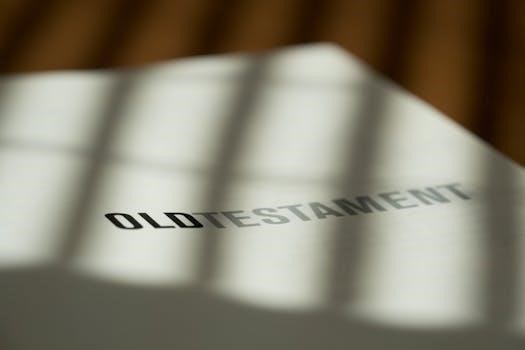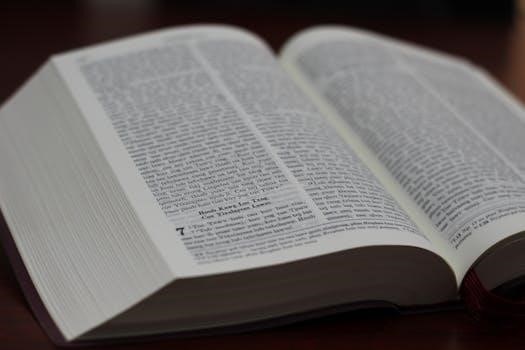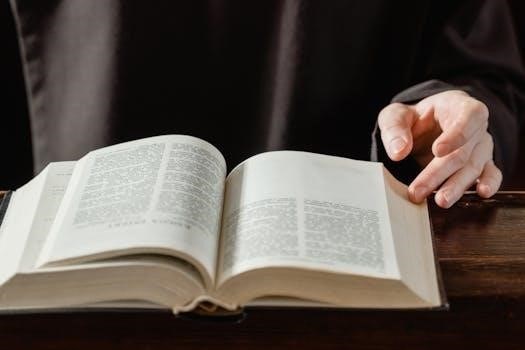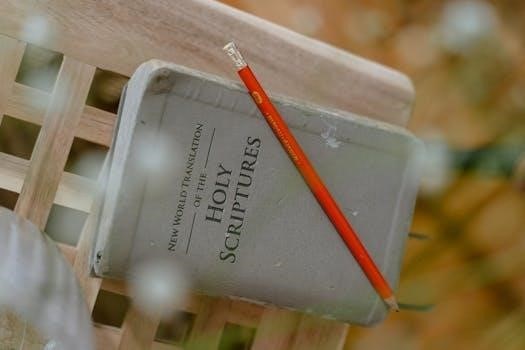Testament Olographe⁚ Guide Complet et Exemple PDF
This comprehensive guide explores the “Testament Olographe,” offering insights into its definition, validity requirements, and practical considerations.
We delve into the nuances of handwritten wills, providing clarity and addressing common questions.
Downloadable PDF examples offer valuable templates, aiding in crafting your own valid document.
Définition et Caractéristiques du Testament Olographe

A “Testament Olographe,” or holographic will, is a will entirely handwritten, dated, and signed by the testator.
Unlike other forms, it requires no notary or witnesses for its initial creation.
Its primary characteristic lies in its complete manual execution, emphasizing personal expression and autonomy.
This distinguishes it from typed or electronically produced wills, demanding authentic penmanship for validity;
The olographic will offers simplicity and privacy, allowing individuals to dictate their final wishes without external intervention.
However, this informality necessitates strict adherence to legal requirements, particularly concerning handwriting, date, and signature.
Its accessibility and ease of creation make it a popular choice, but also susceptible to challenges regarding authenticity or clarity.
The absence of formal validation during its creation places greater importance on its clear and unambiguous language.
Ultimately, the “Testament Olographe” provides a direct and personal means of conveying testamentary intentions, demanding meticulous execution to ensure legal enforceability and prevent future disputes among heirs or beneficiaries.
Its handwritten nature links the document directly to the testator, providing unique evidence of their wishes and intentions.
Conditions de Validité du Testament Olographe (Article 970 du Code Civil)
Article 970 of the French Civil Code meticulously outlines the validity requirements for a “Testament Olographe.”
Crucially, it states the will must be entirely handwritten by the testator.
This excludes any form of typing or electronic generation; every word must be penned by the testator’s own hand.
Furthermore, the document must be dated clearly, indicating the day, month, and year of its creation.
The date’s accuracy is paramount, influencing the will’s precedence in cases of multiple testaments.
Finally, the testator’s signature is essential, authenticating the document and confirming their testamentary intent.
The signature must be unique and recognizable as belonging to the testator.
Absence of any of these three elements – handwritten text, date, or signature – renders the “Testament Olographe” invalid.
The law mandates strict compliance with these formal requirements, emphasizing the testator’s direct and personal involvement in the will’s creation.
These conditions aim to prevent fraud, ensure authenticity, and provide clear evidence of the testator’s wishes.
Compliance with Article 970 is therefore essential for guaranteeing the legal enforceability of a “Testament Olographe.”
Rédaction Manuscrite Intégrale⁚ Importance et Exceptions
The requirement for a completely handwritten “Testament Olographe” is paramount.
This ensures the testator personally drafts the document, confirming their true intentions and capacity.
The handwritten nature serves as proof against undue influence or forgery.
Every word, phrase, and sentence must originate from the testator’s hand, reflecting their unique expression.
The law strictly prohibits any form of mechanical or electronic assistance.
Typed or computer-generated documents are unequivocally invalid as “Testament Olographes.”
Even partial use of non-handwritten elements can invalidate the entire will.
However, jurisprudence has shown some flexibility in exceptional circumstances.
Minor deviations from the handwritten rule may be tolerated if the core testamentary dispositions are clearly handwritten and authenticated.
For example, a judge once admitted the validity of a will written on the side of a washing machine, which demonstrates it can be handwritten on anything.
These exceptions are rare and assessed on a case-by-case basis, focusing on preserving the testator’s intent.
Ultimately, complete adherence to the handwritten requirement is vital for ensuring the “Testament Olographe’s” validity.
Seeking legal counsel when dealing with unusual circumstances is always advisable.
Date et Signature⁚ Exigences et Interprétations Juridiques
The inclusion of a date and signature are crucial for a valid “Testament Olographe.”
The date establishes when the testator created the will, providing a reference point for legal interpretation and potential revocation.
The signature authenticates the document, confirming the testator’s identity and intent to enact the will.
Both the date and signature must be handwritten by the testator themselves.
The date should be clear and unambiguous, specifying the day, month, and year.
Vague or incomplete dates can lead to legal challenges and potential invalidation.
While a precise date is preferred, courts may consider extrinsic evidence to clarify ambiguous dates if the testator’s intent is evident.
The signature must be unique to the testator and demonstrate their conscious decision to finalize the will.
Using a customary signature is sufficient, but initials or nicknames may be questioned.
The signature should appear at the end of the document, signifying its completion.
Jurisprudence demonstrates some flexibility regarding the date’s placement, allowing it elsewhere if clearly indicating the will’s creation time.
However, the signature must always be at the end.
These elements combined make the legal document valid.
Ultimately, adhering to the proper dating and signing conventions is essential for establishing the “Testament Olographe’s” legal standing.
Clarté et Précision des Dispositions Testamentaires
The clarity and precision of the testamentary dispositions are paramount for ensuring the effective execution of a “Testament Olographe.”
The testator’s intentions must be expressed in unambiguous language, leaving no room for misinterpretation or speculation.
Vague or unclear provisions can lead to disputes among beneficiaries and potential legal challenges, defeating the testator’s intended distribution of assets.
Each bequest should clearly identify the specific asset and the intended recipient, using precise descriptions and names.
Avoid using colloquialisms, informal language, or ambiguous terms that could be subject to multiple interpretations.
If referring to specific items, provide detailed descriptions, including serial numbers, identifying marks, or locations.
When designating beneficiaries, use their full legal names and, if possible, their dates of birth to avoid confusion.
Clearly state the percentage or specific amount of the estate that each beneficiary is to receive.
If including conditions or restrictions on bequests, ensure they are clearly defined and legally permissible.
Avoid using language that could be deemed discriminatory or contrary to public policy.
Consider the potential for future changes in circumstances and address them in the will, such as the death of a beneficiary or the sale of an asset.
Seeking legal advice during the drafting process can help ensure that the testamentary dispositions are clear, precise, and legally sound, minimizing the risk of future disputes and maximizing the likelihood of the testator’s wishes being fulfilled.
Capacité Juridique du Testateur
The legal capacity of the testator is a fundamental prerequisite for the validity of a “Testament Olographe.”
To validly execute a will, the testator must possess the mental competence and legal authority to make decisions regarding the distribution of their assets.
This capacity is generally presumed unless there is evidence to suggest otherwise.
However, certain factors can raise concerns about a testator’s capacity, such as advanced age, illness, or cognitive impairment.
The testator must understand the nature of the act they are performing, which includes knowing that they are making a will and disposing of their property.
They must also understand the extent of their property and the identity of the potential beneficiaries.
Furthermore, the testator must be free from undue influence or coercion, meaning that their decisions must be their own and not the result of pressure from others.
If there are doubts about a testator’s capacity, it may be necessary to obtain a medical evaluation to assess their mental state.
The evaluation should be conducted by a qualified professional who can provide an objective assessment of the testator’s cognitive abilities.
If the testator lacks the required capacity, the will may be deemed invalid, and their assets will be distributed according to the laws of intestacy.
It is crucial to address any concerns about capacity proactively to avoid potential legal challenges and ensure that the testator’s wishes are respected.
Révocation du Testament Olographe⁚ Procédures et Validité
A “Testament Olographe” can be revoked, altering or nullifying its provisions.
Revocation can be express, through a new will explicitly revoking the prior one, or implied, through a subsequent will with conflicting dispositions.
To be valid, the revocation must adhere to the same formal requirements as the original will.
An express revocation must be in writing, dated, and signed by the testator.
An implied revocation occurs when a later will makes dispositions inconsistent with the earlier one.
The extent of the revocation depends on the degree of inconsistency; the prior will is only revoked to the extent of the conflict.
Physical destruction of the “Testament Olographe” by the testator, with the intent to revoke it, also constitutes valid revocation.
However, accidental destruction or destruction by someone other than the testator does not revoke the will.
If a revoked will is later found intact, the court may need to determine the testator’s intent at the time of destruction.

It is crucial to clearly state the intention to revoke in any subsequent will to avoid ambiguity.
Revocation should be handled carefully to ensure that the testator’s wishes are accurately reflected in their final testamentary dispositions.
Seeking legal advice is recommended to ensure compliance with all applicable laws and procedures.
Conservation et Enregistrement du Testament Olographe

Proper conservation and registration are vital for ensuring the “Testament Olographe’s” validity and accessibility.
While not legally mandated, registering the will with a notary offers significant advantages.
Registration creates an official record of the will’s existence, reducing the risk of loss or destruction.
The notary will keep the original will in their archives and record its existence in the Central Register of Wills.
This register can be accessed after the testator’s death, making it easier for heirs to locate the will.
If the will is not registered, it should be stored in a safe and secure location known to trusted individuals.
A safety deposit box, a fireproof safe, or the custody of a trusted family member are common options.
Regardless of the chosen method, it is essential to inform the executor or potential beneficiaries of the will’s location.
Clear instructions should be provided to ensure the will can be easily retrieved after the testator’s passing.
Failing to properly conserve and register the “Testament Olographe” can lead to complications and disputes.
Consider consulting with a legal professional to determine the best approach for your specific circumstances.
They can provide guidance on storage options and the registration process, ensuring your testamentary wishes are respected.
Contestation et Nullité du Testament Olographe⁚ Motifs et Procédures
Despite adhering to formal requirements, a “Testament Olographe” can be contested, potentially leading to its nullification.
Several grounds exist for challenging a will, including lack of testamentary capacity, undue influence, and formal defects.
If the testator lacked the mental capacity to understand the will’s contents or consequences, the will may be deemed invalid.
Undue influence occurs when someone exerts pressure on the testator, coercing them into making testamentary dispositions.
Formal defects, such as the absence of a signature or date, can also invalidate a “Testament Olographe.”
The entire will must be handwritten by the testator; typed or printed sections render it null and void.
To contest a will, an interested party must initiate legal proceedings, typically within a specific timeframe.
Evidence must be presented to support the claim of invalidity, such as medical records or witness testimonies.
The burden of proof lies with the party challenging the will to demonstrate its invalidity.
If the court finds the will invalid, the estate will be distributed according to intestacy laws.
This means the assets will be divided among the legal heirs based on a predetermined order of succession.
Contesting a will can be a complex and contentious process, often requiring the assistance of legal counsel.
Seeking legal advice is crucial for understanding the applicable laws and navigating the legal procedures.
Testament Olographe et Traduction⁚ Jurisprudence Récente
The validity of a “Testament Olographe” written in a foreign language and requiring translation has been a subject of recent legal scrutiny.
Jurisprudence has evolved concerning the admissibility and interpretation of translated wills, especially in cases of dispute.
A key question is whether the translated version accurately reflects the testator’s intentions as expressed in the original document.
Courts often consider the translator’s qualifications and the methodology used to ensure the translation’s fidelity.
Ambiguities or discrepancies between the original and translated versions can lead to challenges to the will’s validity.
In some cases, courts may require expert linguistic analysis to resolve interpretive disputes arising from the translation.
Recent case law emphasizes the importance of providing clear and convincing evidence that the translation is accurate and reliable.
This may involve presenting testimony from the translator or other language experts to support the translation’s validity.
The burden of proof rests on the party relying on the translated will to demonstrate its authenticity and accuracy.
If the translation is deemed unreliable or inaccurate, the court may refuse to admit the will to probate.
This can have significant consequences for the distribution of the estate, potentially leading to intestacy.
It is advisable to have a “Testament Olographe” written in a language understood by the testator’s legal advisors.
If a foreign language is unavoidable, ensure the translation is performed by a qualified and certified translator.
Maintaining detailed records of the translation process is crucial for demonstrating its integrity in court.
Modèles et Exemples de Testaments Olographes (PDF)
Accessing well-structured models and examples of “Testaments Olographes” in PDF format can be invaluable when drafting your own will.
These resources provide a framework for understanding the essential components and legal language typically included in such documents.
Examining various examples allows you to see how different individuals have approached the task of expressing their testamentary wishes.
However, it is crucial to remember that these models are for illustrative purposes only and should not be copied verbatim.
Every individual’s circumstances are unique, and your “Testament Olographe” must reflect your specific assets, beneficiaries, and intentions.
Pay close attention to the formatting, clarity, and precision of the language used in the examples.
Ensure that the models you consult comply with the legal requirements of your jurisdiction, as laws may vary.
Using a model as a starting point can save time and effort, but it is essential to personalize the content to fit your needs.
Consider seeking legal advice from a qualified attorney to review your draft and ensure its validity.
PDF examples can also help you identify potential pitfalls or ambiguities in your own writing.
Compare different models to see how they address common issues, such as the distribution of specific assets or the appointment of executors.
Be aware that some models may contain outdated information or clauses that are no longer legally enforceable.
Always verify the accuracy and relevance of any information you obtain from online resources.
Remember, a well-drafted “Testament Olographe” can provide peace of mind and ensure your wishes are honored.
Conseils pour la Rédaction d’un Testament Olographe Valide
Avantages et Inconvénients du Testament Olographe

The “Testament Olographe” presents both notable advantages and potential disadvantages compared to other forms of wills.
One significant advantage is its simplicity and cost-effectiveness; it requires no involvement of notaries or witnesses, making it a readily accessible option.
The testator has complete control over the drafting process, ensuring their wishes are expressed directly and personally.
However, this informality also introduces potential drawbacks.
Without professional guidance, the testator might unintentionally create ambiguities or inconsistencies that could lead to disputes.
The lack of notarization means there’s no official verification of the testator’s capacity or freedom from undue influence.
Its validity hinges entirely on meeting the strict requirements of being entirely handwritten, dated, and signed.
Any deviation from these requirements can render the will invalid.
Furthermore, the “Testament Olographe” may be more susceptible to challenges regarding authenticity or interpretation.
There is no guarantee of proper storage or registration, which can increase the risk of loss or destruction.
While the testator can modify the will at any time, each modification must also adhere to the same strict requirements.
The absence of legal oversight may also result in overlooking important legal or tax considerations.
Careful consideration of these pros and cons is essential before opting for a “Testament Olographe.”
Weigh the convenience and cost savings against the potential risks of ambiguity, invalidity, and legal challenges.
Consulting with a legal professional can provide valuable insights and help you make an informed decision.
